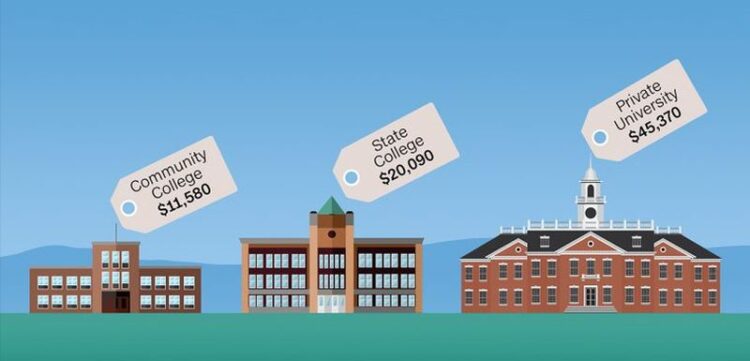The ability to pay for college is a crucial factor that you should consider before enrolling, especially because you have to consider costs like tuition, books, supplies, and personal expenses. The good news is that you can figure out ways to bring the total amount down by prioritizing basic needs, finding deals, and applying for financial assistance.
Page Contents
Tuition

source:elivenet.com
Tuition refers to the charges that colleges require students to pay for the services or instruction offered. It forms one of the largest sources of revenue for learning institutions. Colleges charge these fees either per quarter or semester, and they vary for every institution, so visiting online platforms like CollegeData to gather information can help you weigh your options.
You will pay nearly double the tuition fees to attend a private university than a public one. The charges will vary based on factors like the state, the duration of your course, and the type of college you wish to attend. Students in public universities also pay varying fees depending on whether they are in-state-residents or out-of-state students.
The average costs for the academic years 2019-2020 amount to:
- $36,880 for private institutions
- $26,820 for out-of-state residents
- $10,440 for in-state residents
Private colleges cost more because they rely on student fees to keep their institutions operational while public ones get funding from the government. In-state residents also pay less because their tax dollars finance the state.
Campus Fees

source:irlande.campusfrance.org
These are usually included in the tuition fees to cover specific services like campus transportation, libraries, athletic facilities, and student government.
Some universities charge more campus fees than others. Students attending the University of California, Irvine, pay a “campus spirit fee”, which goes to assist the spirit programs and athletics in the school. Additionally, the school also charges a “green initiative fee” to fund the campus’s quest to lower its carbon footprint.
Room and Board

source:collegexpress.com
If you choose to live on campus, then you will need to pay for the room. Also called a dorm, your room comes with basic necessities like a bed, desk, chair, and a dresser or closet. It also includes water, heat, electricity, and even WiFi.
Besides accommodations, the school may also provide a meal plan, which refers to the school’s estimated costs of food for the time you will spend in school.
Room and board charges vary from one institution to another. Some colleges offer off-campus living meal estimates while others offer various types of meal plans for all students. You may also receive a certain amount of university dollars or points to spend each semester.
For the 2019-2020 academic year, the average costs of room and board are $11,510 at public universities and $12,990 at private universities. But overall, the amount of money you will pay will depend on the housing plan, the type of university, and whether you are an out-of-state or in-state student.
Books and Supplies

source:pxfuel.com
The prices of college textbooks have seen an 82% rise from 2002 to 2013, which amounts to about three times the inflation rates. Since one textbook may cost you up to $200, it’s likely that you will spend $1,240 each year purchasing books in both private and public colleges.
Unfortunately, due to high costs, many students may choose not to buy the assigned book, even with the knowledge that the decision may lead to lower grades. The inability to buy books could also lead to students taking fewer courses and graduating later.
You can minimize these expenses by purchasing second-hand books, borrowing from the library, and renting/buying digital or loose-leaf copies. For example, while a Campbell Biology (11th Edition) costs over $200, you can find the digital copy at about $120, and a loose-leaf will cost you about $165. You can also make use of the Open Educational Resources (OER), where you can find book discounts, membership services, and utilize buyback offers.
Transportation
Living on campus reduces the transport expenses while you are away in college because you can walk from your dorm to the other side of campus with ease. Most campuses are also near plenty of shopping and dining, so on-campus students can also walk to these, depending on their distance from the campus.
Living off-campus means you have to commute to and from school. Owning a car also comes with additional expenses such as parking, gas, insurance, and maintenance. Your school may require a parking pass for certain areas on campus or provide an estimate for the average amount of money you will likely need to spend.
Personal Expenses

source:elivenet.com
Living in dorms gives you access to many essential commodities. However, you will need to make payments for items like food, entertainment, clothing, and other personal items, like health insurance, medications, and a phone plan. You also don’t want to underestimate the costs of toiletries, cosmetics, laundry, and groceries, so it’s best to make sure you consider these expenses when creating a budget.
You may also need to furnish your room, pay for activities like concerts, sports, fraternity/sorority fees, and computer-related expenses like software purchases. All these items and extracurriculars could cost up to $2,000 each semester.
How to Pay for College

source:pxhere.com
There are several ways to access money to pay for college, like securing a scholarship and getting financial aid. Savings and income form a small portion of how parents pay for their children’s college education. Grants and scholarships accounted for 31% of the ways of covering college expenses in the 2018-19 school year.
Financial Aid
Financial aid is available on merit or an as-needed basis and comes in various forms, such as:
- Grants
- Scholarships
- Private or federal loans
- Work-study programs
The amount of money you receive depends on the guidelines laid down by institutions, state, and the federal government. The money covers enormous expenses such as transportation, books, tuition, room and board, and books.
You can apply for financial aid by filing the Free Application for Federal Student Aid (FAFSA). Colleges, universities, and state agencies use this tool to decide how and whom the award goes to. Private learning institutions use an additional and more detailed form known as the College Scholarship Service (CSS).
Grants and Scholarships

source:pxfuel.com
Grants and scholarships are a type of financial assistance that does not require repayments. It is best to start looking for awards early, so be sure not to wait until your senior year of high school to begin your search. There are several scholarships you can apply for—all you have to do is do well in school, stand out from your other classmates, narrow your selection using a search tool, and follow every little detail in your application.
With a comprehensive and strategic plan, you can cover your college fees and receive the education you require with ease.





